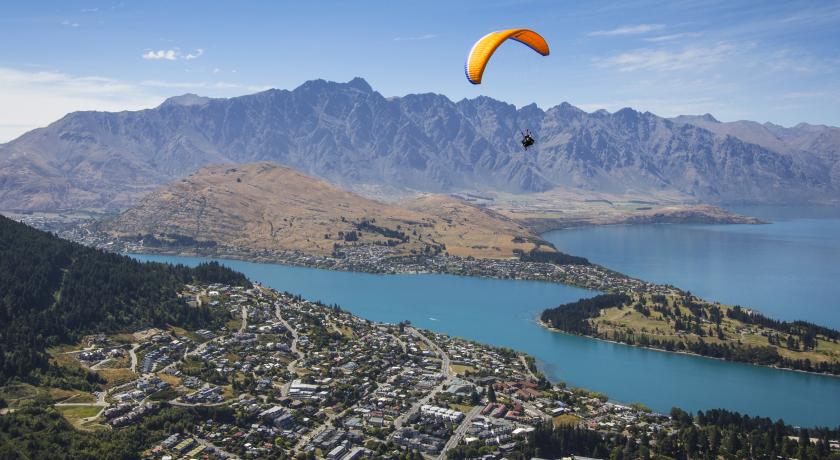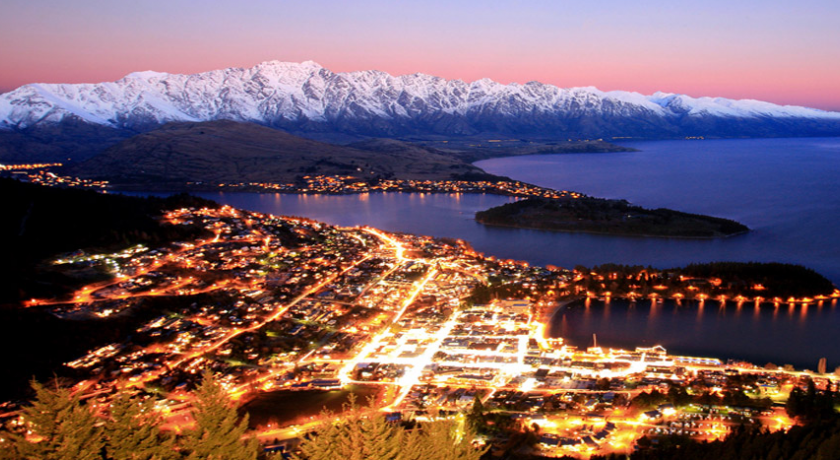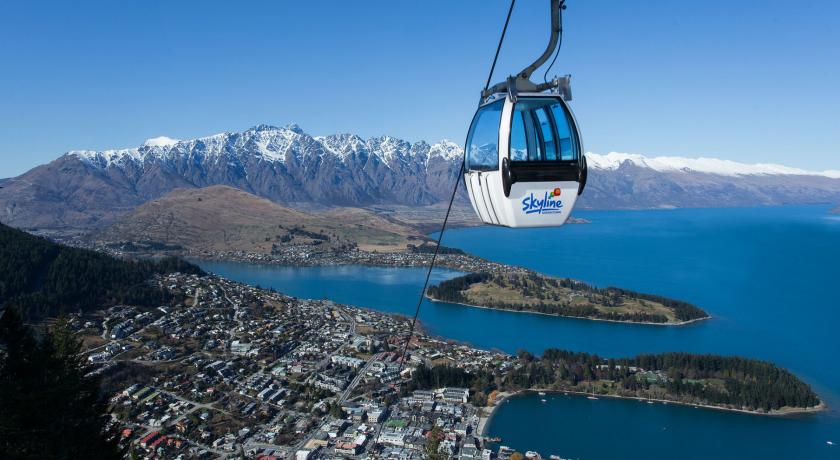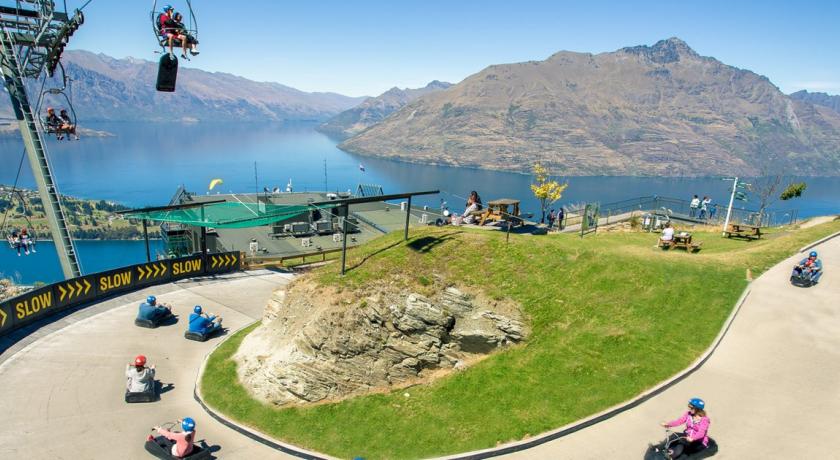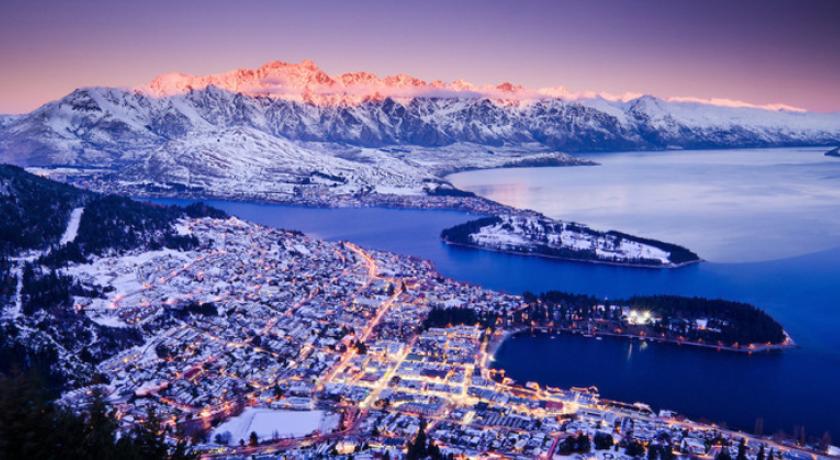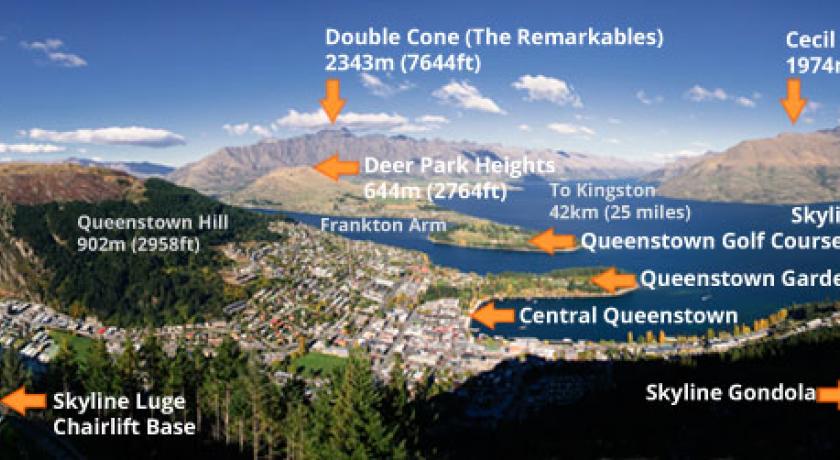Description
Queenstown (M─üori: T─ühuna) is a resort town in Otago in the south-west of New Zealand's South Island. It has an urban population of 15,300 (June 2017), making it the 27th largest urban area in New Zealand. In 2016, Queenstown overtook Oamaru to become the second largest urban area in Otago, behind Dunedin.
The town is built around an inlet called Queenstown Bay on Lake Wakatipu, a long thin Z-shaped lake formed by glacial processes, and has views of nearby mountains such as The Remarkables, Cecil Peak, Walter Peak and just above the town; Ben Lomond and Queenstown Hill.
The Queenstown-Lakes District has a land area of 8,704.97 square kilometres (3,361.01 sq mi) not counting its inland lakes (Lake H─üwea, Lake Wakatipu, and Lake Wanaka). The region has an estimated resident population of 37,100 (June 2017). Its neighbouring towns include Arrowtown, Glenorchy, Kingston, Wanaka, Alexandra, and Cromwell. The nearest cities are Dunedin and Invercargill. Queenstown is known for its commerce-oriented tourism, especially adventure and ski tourism.
History
M─üori settlement and presence
The area was discovered and first settled by M─üori before non-M─üori arrived. The first non-M─üori to see Lake Wakatipu was European Nathanael Chalmers who was guided by Reko, the chief of the Tuturau, over the Waimea Plains and up the Mataura River in September 1853. Evidence of stake nets, baskets for catching eels, spears and ashes indicated the Glenorchy area was visited by M─üori. It is likely Ng─üi Tahu M─üori visited Queenstown en route to collect Pounamu (greenstone). There was a settlement called Te Kirikiri Pa occupied by the tribe of K─üti Mamoe which was situated in the location of the current Queenstown Gardens, but by the time European migrants arrived in the 1860s this settlement was no longer being used.
Subsequent European settlers
European explorers William Gilbert Rees and Nicholas von Tunzelmann were the first non-Maoris to settle the area. Rees established a high country farm in the location of Queenstown's current town centre in 1860, but the discovery of gold in the Arrow River in 1862 encouraged Rees to convert his wool shed into a hotel named the Queen's Arms, now known as Eichardt's. Many Queenstown streets bear names from the gold mining era (such as Camp Street) and some historic buildings remain. William's Cottage, the Lake Lodge of Ophir, Queenstown Police Station, and St Peter's Anglican Church lie close together in a designated historic precinct.
Naming
There are various apocryphal accounts of how the town of Queenstown was named however the following is the most likely:
When William Rees first arrived in the area and built the homestead the area was known as The Station although miners soon referred to it as The Camp from 1860 to 1862.
The miners and especially the Irish had taken an interest in the ceremony held for a small town called The Cove in Ireland which was renamed to Queenstown in honour of Queen Victoria in 1850. They may have had their own ceremony at the intersection of Rees and Beach Streets replicating some of the elements in the renaming of the Irish town.
Subsequent to this a public meeting was held for the purpose of naming the township on the lake in January 1863 (probably the weekend of the 3rd and 4th) in which the town was officially given the name of Queenstown in reference to Ireland's Queenstown. By 9 and 10 January 1863 the town was being reported with the name of Queenstown from several reports written by a correspondent in the Otago Witness on Monday the 5th and Tuesday the 6th. It was during the meeting there may have been a reference by a miner of the town being "fit for a Queen" (this is one of the most popular accounts of how the town was named).
The M─üori name for Queenstown of T─ühuna means shallow bay.
Geography
Queenstown is situated on the shore line of Lake Wakatipu, the third largest lake by surface area in New Zealand. It is at a relatively low altitude for a ski and snowboarding centre at 310 metres above sea level on the shores of the lake, but nestled among mountains. There are close-by gorges and some plains suitable for agriculture.
Suburbs
Central Queenstown contains many businesses, apartments and homes but is near many suburbs or large areas of housing which are: Fernhill, Sunshine Bay, Queenstown Hill, Goldfield Heights, Marina Heights, Kelvin Heights, Arthurs Point and Frankton. Just outside Queenstown are the areas of: Arrowtown, Closeburn, Dalefield, Gibbston, Jack's Point, Hayes Creek, Lake Hayes Estate, Shotover Country and Quail Rise.
Climate
Because of its relatively moderate altitude (310 metres) but with high mountain surroundings, it has an oceanic climate (Köppen climate classification Cfb). Summer has long warm days with temperatures that can reach 30 °C while winters are cold with temperatures often in single digits with frequent snowfall, although there is no permanent snow cover during the year. As with the rest of Central Otago, Queenstown lies within the rain shadow of the Southern Alps, but being closer to the west coast the town is more susceptible to rain-bearing fronts compared to nearby Cromwell, Wanaka and Alexandra. The hottest recorded temperature in Queenstown is 34.1 °C (93 °F), while the coldest is −8.4 °C (17 °F).
Economy
Growth and affordability
Residential housing in the Queenstown area is quite expensive due to factors such as the town being a tourist destination, its lack of land and its desirability to foreigners and investors. Queenstown is rated the least affordable place in New Zealand to buy a property overtaking Auckland at the start of 2017. In December 2016 the average house price in the Queenstown area became $1 million NZD.
Employment
The growth in the area is one of the largest in the country with the population growing 7.1% from 2015 to 2016 in a 12-month period. Most jobs in Queenstown are tourism or accommodation related. Employment growth was also the highest of any area in New Zealand at 10.3% in the March 2016 year.
Tourism
A resort town, Queenstown boasted 220 adventure tourism activities in 2012. Skiing and snowboarding, jet boating, whitewater rafting, bungy jumping, mountain biking, skateboarding, tramping, paragliding, sky diving and fly fishing are all popular.
Queenstown is a major centre for snow sports in New Zealand, with people from all over the country and many parts of the world travelling to ski at the four main mountain ski fields (Cardrona Alpine Resort, Coronet Peak, The Remarkables and Treble Cone). Cross country skiing is also available at the Waiorau Snowfarm, near Cardrona village.
The 100-year-old twin screw coal fired steamer TSS Earnslaw traverses Lake Wakatipu.
Queenstown lies close to the centre of a small wine producing region, reputed to be the world's southernmost. The Two Paddocks vineyard is owned by local actor Sam Neill. Neighbouring, historic Arrowtown features restaurants and bars.
Other tourist activities include:
- Ben Lomond, a nearby mountain for a view of the area
- The Skyline Gondola ascends Bob's Peak on Ben Lomond
- Kiwi Birdlife Park and Paradise for the paradise duck (Tadorna variegata)
- Walk, mountain bike, or run The Queenstown Trail
- Skippers Road
- Scenic flights
Culture
Festivals
Queenstown has many festivals. In 2013, examples include Bike Festival (March/April), Winter Festival (June), and Jazz Festival (October).
Locations for television and film
Jane Campion's six-part drama mystery Top of the Lake was shot during 2012 for pay TV release in 2013. The lakes of the Wakatipu appear ominous, and the Southern Alps spectacular. The main location is Moke Lake and scenes were shot on Lower Beach Street and Coronation Drive, and at a supermarket and bottle store on Shotover Street.
In 2010, Cycle 14 of America's Next Top Model, was, in part filmed in Queenstown. The cycle was won by Krista White. Raina Hein was runner up.
Queenstown and the surrounding area contains many locations used in the filming of The Lord of the Rings film trilogy. Locations used include Paradise near Glenorchy, at the head of Lake Wakatipu.
Queenstown became popular in South Asia after the release of Bollywood Blockbuster Kaho Naa... Pyaar Hai which was partially shot there. Starring sensational debuts by Hrithik Roshan & Amisha Patel it was this film that opened the doors for both tourists and filmmakers from India to New Zealand with Queenstown being the most sought after destination. Queenstown featured for 17 minutes in I Hate Luv Storys, a 2010 Bollywood romantic comedy. Queenstown and the surrounding areas were also used in the 2009 X-Men Origins: Wolverine film. Mee-Shee: The Water Giant was shot in Queenstown in 2005, and released to DVD in the same year. Queenstown was also used to film most of the 1988 The Rescue. Queenstown was the base for filming the George Lucas 1988 fantasy film Willow.
Filming of the 1981 film Race for the Yankee Zephyr took place in and around Queenstown, the first major motion picture production for the area.
A 1989 TV Commercial for the Toyota Hilux starring Barry Crump and Lloyd Scott in which the two drive off the cliff was filmed at nearby Queenstown Hill.
The first and last episodes of the fifth season of The Mole were filmed in Queenstown.
The 2017 Filipino drama film Northern Lights was shot entirely on location in Queenstown substituting for the setting of Alaska.
In 2017 the Korean variety show Running Man shot an episode in Queenstown, where Haha & Yang-Se Chan took a penalty at the Nevis Swing.
Sports and Recreation
- Queenstown Events Centre and stadium
- Paragliding or Hang Gliding
- Aerobatics with the Wakatipu Aero Club at Queenstown Airport at Frankton
- Golf at Millbrook Resort, Jack's Point, or Queenstown Golf Club
- Disc golf at the Queenstown Gardens
- Tennis at the Queenstown Tennis Club in Queenstown Gardens
- Cricket at the Queenstown Cricket Club
- Netball at the Wakatipu Netball Centre
- Rugby league and Rugby union at the Wakatipu Rugby League Club Memorial Park
- Touch rugby during the summer season
- Scuba diving or snorkeling in a river, bridge wreck, or in Lake Wakatipu
- Adventure sport, canyon-swing, parachute, jetboat, bungy jump, river-surf, or kitesurf
In the Area
- Central Otago region
- Central Otago wine region
- History of the Central Otago Gold Rush
- Milford Road, Milford Sound / Homer Tunnel, the Fiordland Lakes / Doubtful Sound
- Tramping track near Glenorchy
- Routeburn, one of the New Zealand Great Walks
Transport
Queenstown is accessible by road and air but not by rail (similar to Kaitaia, Taupo and Nelson).
As a resort centre, there are many bus services that operate into Queenstown, with most being for package tours, but daily services for the local or itinerant are available to and from Invercargill, Dunedin and Christchurch, which are the main cities closest to Queenstown.
Queenstown Airport receives flights from Australia by Air New Zealand, Qantas, Virgin Australia and Jetstar and in particular, to Brisbane, Gold Coast, Melbourne, and Sydney (the frequency is much increased over the ski season and during summer). Domestic flights operate to Auckland, Christchurch, Dunedin, Hamilton, Nelson and Wellington. It is New Zealand's busiest helicopter base, also the fourth busiest airport by passenger traffic, and is also heavily used for tourist 'flightseeing', especially to Milford Sound and Mount Cook, using both fixed-wing and rotary-wing aircraft.
The primary road access to the Queenstown area is via State Highway 6 (SH6), which travels from Cromwell through the Kawarau Gorge to Frankton, where a 9 km spur (SH6A) leads to the CBD and connects with the Glenorchy Road. SH6 continues south, crossing the Kawarau river before heading down the eastern side of Lake Wakatipu to Kingston before crossing the provincial boundary and emerging on the plains of Southland, terminating in the city of Invercargill. A difficult road over the Crown Range leads to Cardrona skifield and Wanaka, and is New Zealand's highest paved public road pass.
Queenstown is the departure point for a large number of day trips to the Milford Sound, which entails a return trip of approximately 12 hours. There are scenic flights available to Milford Sound. A return flight, including a two-hour cruise, is approximately four hours.
Education
Wakatipu High School is a government co-ed school which services the community for students in years 9–13.
Primary schools catering to students in years 1–8 in the Queenstown area are: KingsView, Queenstown, Remarkables, St Joseph's and Shotover.
Southern Institute of Technology (SIT), based in Invercargill, has a campus in Queenstown.
Queenstown Resort College actively supports events for international travel agents.
ACE Wakatipu has a community focus, and provides links to many adult training opportunities.
Nestled on the banks of Lake Wakatipu, Queenstown (Maori name Tahuna) is one of New Zealand’s most loved tourist and holiday destinations. The town is settled right at the lake’s edge, surrounded by scenic mountain ranges.
The Wakatipu Basin was created by glacial movement some 15,000 years ago. Evidence of Maori presence has been found dating back around 700 years, though the area was apparently not settled by Maori; rather, they used it as a summer hunting ground for the huge, flightless moa and the treasured pounamu, or greenstone, which was found there.
The first European visitor was the Scottish-born settler Nathanael Chalmers, in 1853. Reko, a Maori chief, led Chalmers on what was probably the first high octane tour – an off-road trip crossing mountain ranges, canoeing rivers and finally speeding through the Cromwell Gorge on a raft made of flax stems. More than 50 years later, Chalmers recalled the trip: “I shall never forget the “race” through the gorge … my heart was literally in my mouth, but those two old men seemed to care nothing for the current.” He paid his ‘guide’ with a three-legged iron pot – and white water rafting remains a popular sport to this day!
A few years after Chalmers’ rafting adventure, William Rees and Nicholas von Tunzelmann settled on the shores of Wakatipu – Rees on what is now Queenstown, and von Tunzelmann across the lake. The friends married two sisters, Frances and Gertrude Gilbert. It was 1860, and the settlers had a couple of years of peaceful farming before the gold rush of 1862 turned the area into a shanty town; within a few months more than 1,500 miners were literally camped at their doorsteps.
Rees’ land lease was withdrawn and he received a hearty payout to vacate it; however across the lake, von Tunzelmann ran into financial difficulties and had to abandon his land – leaving the Von River and Mt Nicholasnamed as his legacy.
As the gold ran out and the miners left, Chinese miners were brought in to work the Wakatipu Basin. About 5,000 Chinese workers settled in Otago in the late 1800s. The old Chinese goldmining settlement at Arrowtown has been restored as an historical attraction.
By the early 1900s, the gold was mostly gone; the miners had ‘followed the colour’ to different fields, the Chinese had either returned to China or gone to other parts of the country. The population of thousands dropped to less than 200.
The area continued as farmland, particularly sheep stations, and as a summer holiday destination. Bushwalking and tramping were on offer, with the Milford, Routeburn and Hollyford Tracks at the doorstep. With the establishment of Coronet Peak Ski Field in the mid 1900s, Queenstown began its rise as one of New Zealand’s favourite holiday destinations. Access and accommodation improved; as more people came from overseas, the tourist industry boomed.
When AJ Hackett started a Bungy Jumping operation off the Kawarau Bridge in 1988, Queenstown was well on the way to establishing itself as ‘the adventure tourism capital of the world’. Great expectations maybe; but today this small lakeside town has well over 200 adventure tourism activities on offer, amidst a setting of unparalleled natural beauty, and has international acclaim as an environmental and adventure tourism resort.
How Queenstown Became the Adventure Capital of the World
by Queenstown, NZ / 8 Min Read
Queenstown was carved out of the land by glaciers, rivers and lakes, but it has been shaped by innovative adventurers and entrepreneurs drawn to the region from all over the world to make this place home.
Thanks to generations of daring and determined people, Queenstown is a diverse adventure playground, easily accessed by visitors from around the globe. But it wasn’t always so. Before the ease of travel we now take for granted, getting to Queenstown was an adventure in itself – often an incredibly difficult one.
For centuries, Maori had forged trails through the region for seasonal hunting prospects and prized pounamu (greenstone). However, early attempts to reach Lake Wakatipu by European adventurers failed miserably until Maori chief Reko guided the first party to the shores of Lake Wakatipu in 1856.
Once an access way was established, the first pioneers of the district quickly followed, looking for fertile pastureland and soil for farming. Queenstown delivered, but at a price. Lake Wakatipu and the wide, rapid rivers it linked with claimed the lives of many who tried to cross. Back on land, steep mountains, flash floods and heavy snow were just a few of nature’s hardships these sturdy settlers had to overcome.
When gold was discovered in 1862 more adventurous souls descended on Queenstown. Mining life was not only brutal, it was also often fatal. These men and women needed great determination and courage to survive in basic living conditions, in generally remote and difficult to reach places. Along with the tough geography of the land, they had to contend with mud, floods, ice and snow. Infants were often transported in gin cases slung over the backs of packhorses, with one child swinging on each side as the animal picked its way across sheer, narrow mountain trails. When the gold ran out, many of these intrepid pioneers created other means of income to ensure they could stay on and raise families.
The first miners embarked on incredible journeys over cliffs and mountains to reach quartz reefs. For farmers, mountain climbing was simply part of living and working on high country stations. It was only when the Reverend W.S. Green attempted to ascend Mt Earnslaw in March 1882 that mountaineering officially became a sought-after adventure sport in Queenstown.
Eight years after the Reverend Green’s unsuccessful attempt, the honour of conquering Mt Earnslaw went to well-known Glenorchy guide Harry Birley. Harry built a large cairn of rocks at its peak which concealed a bottle of Irish Moss with a bent shilling inside. Unfortunately for Harry, many locals did not believe he had made it, but he was vindicated two years later with the next successful ascent, when brothers Malcolm and Kenneth Ross retrieved the shilling. More than a hundred years later, thousands of mountaineers, rock climbers, abseillersand canyoners have since had the chance to explore and conquer Queenstown’s valleys and peaks.
By the turn of the 20th century it was the region’s many walking and hiking trails that were creating the summer demand for adventuretourism. Visitors would arrive from all over New Zealand, and the world, to experience the unique landscapes, to earn the glorious views from nearby hills and surrounding mountain peaks, or to walk remote hiking gems such as the Milford, Routeburn or Hollyford tracks. Today, many of these trails are also enjoyed by cyclists, mountain bikers and marathon runners.
Queenstown eventually became a more accessible year-round destination thanks to the invention of motor cars and fixed wing planes. When tourism pioneer and ski enthusiast Sir Henry Wigley invented a special ski-plane in the 1950s, he created a market for private backcountry snow experiences – a service now offered by helicopter. A few years prior to this, in 1947, Sir Henry had also helped his good friend and inventor Sir William (Bill) Hamilton install the very first rope ski tow at Coronet Peak, creating the country’s first commercial ski resort and firmly establishing Queenstown as a winter destination.
Water adventures have expanded to include kayaking, white water rafting, river surfing and sledging.
Bill Hamilton can also take the credit for inventing another adventure activity that Queenstown is now famous for: jet boating. Originally developed to give him the ability to travel up the shallow braided rivers that crossed his farm, his unique water jet propulsion design allowed his boats to travel at high speeds in shallow waters that were previously inaccessible using conventional propeller-driven craft. By 1960, commercial jet boats were thrilling tourists up and down the Shotover and Kawarau rivers.
When commercial white water rafting followed in 1974, the rivers that had once made life hazardous for early settlers began providing adrenalin-filled adventures for thousands of visitors. Today, these water adventures have expanded to include kayaking, white water rafting, river surfing and sledging. Over on Lake Wakatipu, visitors can also experience kite skiing, parasailing, or even diving beneath the water in the world’s first commercial Seabreachers.
Possibly the most famous Queenstown world first is the commercial Bungy operation that launched on 12th November 1988, at the historic Kawarau Bridge. Initially considered to be a passing fad by many locals, the bungy jump quickly became an international phenomenon – and an essential Queenstown initiation rite for thousands of visitors every year. In turn, the bungy has inspired more world-first, gravity-defying adventures such as canyon swings and zip rides, each one complementing the natural landscape they are set in.
Queenstown is also the birthplace of tandem paragliding, pioneered by the late Bruce Grant. The sport was launched commercially in 1990, along with freefall photography. In fact, some of the finest views of this stunning area are now enjoyed from the sky. Admiring visitors can look up towards the mountains and see equally spellbound paragliders, hang gliders and skydivers gazing back down.
Arguably, any one of the adventure activities on offer in Queenstown would be enough for most...
For those who prefer to remain seated, the Skyline Gondola also offers amazing views over Queenstown. Built in 1968, it’s the steepest gondola ride in the Southern Hemisphere, which is a decent adrenalin rush for most people. But if that isn’t enough, the luge ride at the top should do the trick.
Arguably, any one of the adventure activities on offer in Queenstown would be enough for most, but in September 2014 Kiwi adventure sportsman Chuck Berry became the first person to complete the newly-launched 5X1NZ adrenalin adventure, which covers five iconic local adventure activities in a day: skydiving, snowboarding, mountain biking, bungy jumping and jet boating!
The wave of interest in adventure has created an environment for other innovators and entrepreneurs to follow in the wake of early pioneers, further reinforcing Queenstown’s reputation as “The Adventure Capital of the World”.
Today, the rough and often steep and winding trails, previously traversed by wagons, packhorses and feet, are exhilarating backcountry 4-wheel drive and mountain biking adventures. Remote peaks that once took days or weeks to climb are now just a helicopter ride away.
But the intrepid energy of the daring adventurers and entrepreneurs who have passed through over the centuries is still palpable wherever you go in Queenstown. It’s in the rugged mountains, the green valleys, the dusky plains and the sparkling turquoise waters. It’s in the people who call this amazing place home.
Notable people
- Sam Neill (born 1947), actor, has a home in Queenstown.
- Tim Bevan (born 1957), film producer, was born in Queenstown.
- Jaime Passier-Armstrong (born 1981), actress, was born in Queenstown.
- Jane Taylor, lawyer and current Chair of New Zealand Post, lives in Queenstown.
- Kim Dotcom, internet entrepreneur
Sister cities
- Aspen, Colorado, United States
- Hangzhou, Zhejiang
See also
- Tourism in New Zealand
Bibliography
- Reed, A. W. (2002). The Reed Dictionary of New Zealand Place Names. Auckland, New Zealand: Reed Books. ISBN 0-7900-0761-4.
References
External links
- Queenstown Lakes District Council
- Queenstown Tourism official site
- Queenstown at Curlie (based on DMOZ)
Source: https://en.wikipedia.org/wiki/Queenstown,_New_Zealand
Address
New Zealand
Lat: -45.031841278 - Lng: 168.661682129



